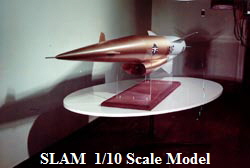|
|||||||
|
Electronics
Guidance To deliver multiple warheads with precision over long ranges required a dual guidance system. Inertial systems were available but were not capable of surviving in the harsh radiation environment. The impetus of the program resulted in the development of gas dynamic bearings for gyroscopes, and radiation-resistant, or “hardened” components which were evaluated in the Air Force NARF facility. These tests showed that inertial guidance systems could be made which would satisfy the mission requirements if midcourse and terminal corrections could be made. The Vought- funded studies associated with SLAM developed a precise system for such an application. This system was patented under the name of FINGERPRINT. The name was changed to TERCOM when the rights were assigned to the U.S.A.F. and is still known today by that name when used in the cruise missile. The system employs terrain contour information along the flight path stored in a digital matrix. A matrix of terrain elevations was concluded to be as distinctive as the human fingerprint. Elevations of all land areas of the earth were available from contour maps. Downward- looking radar on the missile then compares the real elevations with the stored data and the missile position is determined and corrections made to direct it toward the target. Several TERCOM fixes could be made as SLAM proceeded to multiple targets. Extensive flight testing over all types of terrain, with and without snow cover, verified that accurate missile locations could be obtained. All the required hardware was verified in the NARF facility as being suitable for operation in a radiation environment. SLAM Description: Airframe |

 Because the SLAM reactor would operate at high radiation levels without shielding, finding suitable electronics that could operate even for the few hours lifetime required was a daunting task. Careful selection and substitution of insulation materials, potting compounds, and semiconductors in a full complement of missile electronics such as guidance and control, telemetry and instrumentation was made with industry assistance. The largest radiation effects test ever conducted took place in 1964 in the Air Force’s NARF facility at General Dynamics under SLAM Program sponsorship. It was demonstrated that suitable system electronics were or could be made available for the SLAM mission.
Because the SLAM reactor would operate at high radiation levels without shielding, finding suitable electronics that could operate even for the few hours lifetime required was a daunting task. Careful selection and substitution of insulation materials, potting compounds, and semiconductors in a full complement of missile electronics such as guidance and control, telemetry and instrumentation was made with industry assistance. The largest radiation effects test ever conducted took place in 1964 in the Air Force’s NARF facility at General Dynamics under SLAM Program sponsorship. It was demonstrated that suitable system electronics were or could be made available for the SLAM mission.